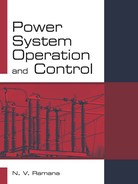QUESTIONS FROM PREVIOUS QUESTION PAPERS
- A power system consists of two 100MW units whose input cost data are represented by the equations:
C1 = 0.04P12 + 22P1 + 800Rs/hourC2 = 0.45P22 + 15P2 + 1000Rs/hour
If the total received power PR = 150 MW, determine the load division between the units for the most economic operation.
-
- Explain with a diagram the physical interpretation of the co-ordination equation.
- Give the various uses of the general loss formula and state the assumptions made for calculating Bmn coefficients.
- 150MW, 220MW and 220MW are the ratings of three units located in a thermal power station. I their respective incremental costs are given by the following equations:
dc1/dP1 = Rs(0.11P1 + 12)dc3/dP3 = Rs(0.1P3 + 13)dc2/dP2 = Rs(0.095P2 + 14)
Where P1, P2,P3 are the loads in MW. Determine the economical load allocation between the three units, when the total load on the station is
- 350MW
- 500MW
- The incremental fuel costs for two plants are given by

Where C is in Rs./Hr and P is in MW. If both units operate at all time and the maximum and minimum load on each unit are 100 MW and 20 MW respectively, determine the economic operating schedule of the plant for loads of 40 MW, 120 MW and 180 MW.
-
- Explain the significance of equality and inequality constraints in the economic allocation of generation among different plants in a system.
- Derive the condition for economic scheduling of generators in a plant.
- Derive the conditions to be satisfied for economic operation of a lossless power system.
-
- Incremental fuel cost in rupees per megawatt hour for two units comprising plant is given by the following equations.

Assume that both units are operating at all times, that total load varies from 40 to 200 MW and that the maximum and minimum loads on each unit are to be 125 and 20 MW respectively. Find the incremental fuel cost and the allocation of loads between units for the minimum cost of various total loads. Derive the formula used.
- Discuss the costs associated with hydro plants.
- Incremental fuel cost in rupees per megawatt hour for two units comprising plant is given by the following equations.
- Give an algorithm for the economic allocation of generation among* generators of a thermal system taking into account transmission losses. Give the steps for implementing this algorithm, and also derive necessary equations.
-
- Discuss and define the loss formula coefficients.
- What is the objective in economic scheduling?
- Discuss the optimization of power flow with suitable cost function without inequality constraints.
-
- Develop the loss formula coefficients for a two plant system. State the assumptions made.
- The transmission loss coefficients in p.u. on a base of 100 MVA are given by

The three plants, A, B and C supply powers of PA = 100MW, PB = 200MW, PC = 300MW into the network. Calculate the transmission loss in the network in MW and the incremental losses with respect to plants A, B, C.
- The incremental fuel costs for two plants are given by

The system is operating at P1 = P2 = 100 MW and ∂ P1/∂ P2 = 0.9. Find the penalty factor of plant 1 and the incremental cost of received power.
- What are Bmn coefficients? Derive them.
